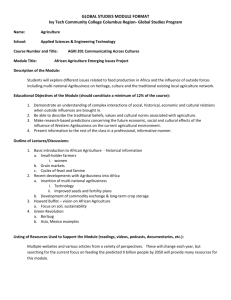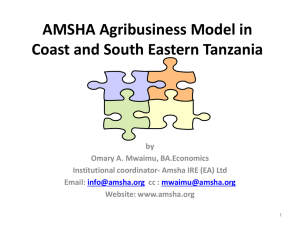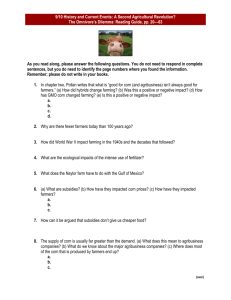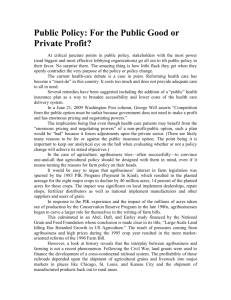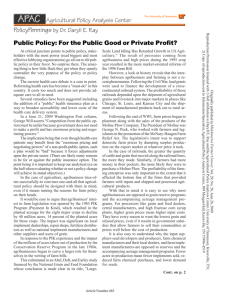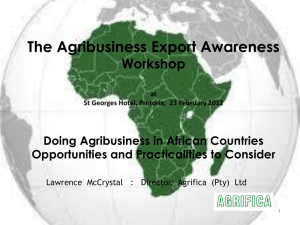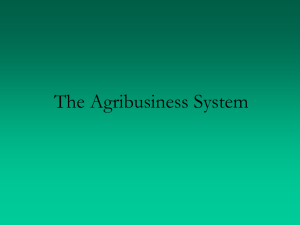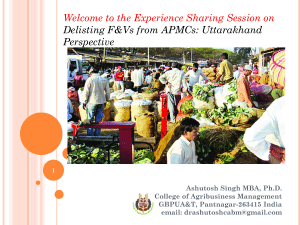THE AGRIBUSINESS MARKETING SYSTEM
advertisement
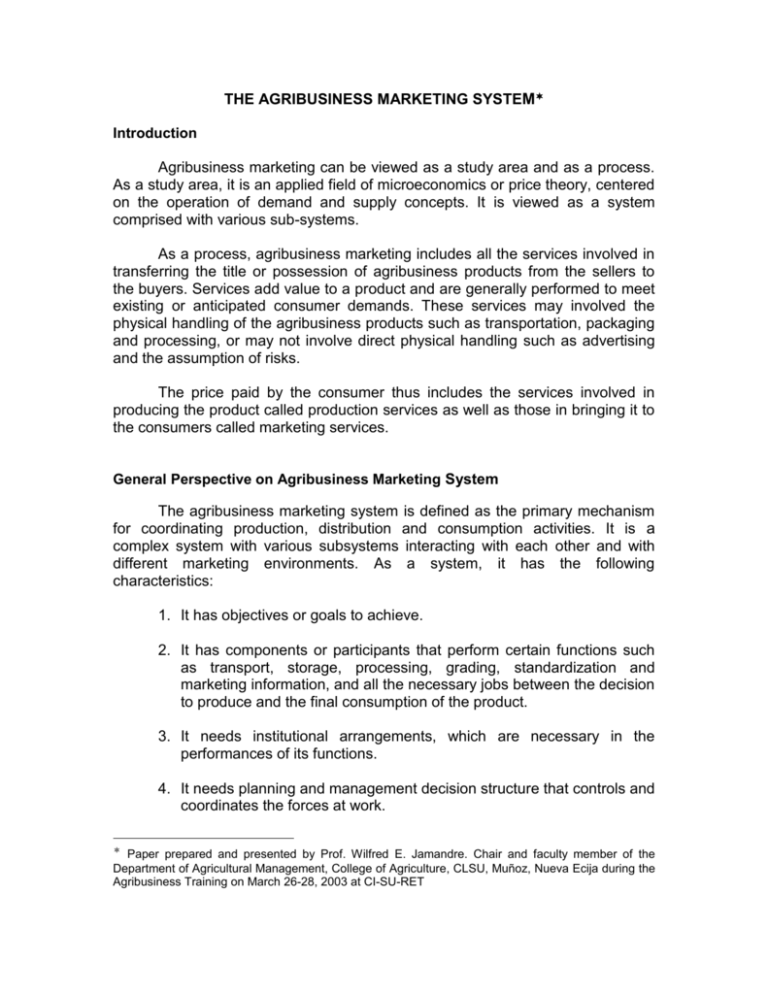
THE AGRIBUSINESS MARKETING SYSTEM Introduction Agribusiness marketing can be viewed as a study area and as a process. As a study area, it is an applied field of microeconomics or price theory, centered on the operation of demand and supply concepts. It is viewed as a system comprised with various sub-systems. As a process, agribusiness marketing includes all the services involved in transferring the title or possession of agribusiness products from the sellers to the buyers. Services add value to a product and are generally performed to meet existing or anticipated consumer demands. These services may involved the physical handling of the agribusiness products such as transportation, packaging and processing, or may not involve direct physical handling such as advertising and the assumption of risks. The price paid by the consumer thus includes the services involved in producing the product called production services as well as those in bringing it to the consumers called marketing services. General Perspective on Agribusiness Marketing System The agribusiness marketing system is defined as the primary mechanism for coordinating production, distribution and consumption activities. It is a complex system with various subsystems interacting with each other and with different marketing environments. As a system, it has the following characteristics: 1. It has objectives or goals to achieve. 2. It has components or participants that perform certain functions such as transport, storage, processing, grading, standardization and marketing information, and all the necessary jobs between the decision to produce and the final consumption of the product. 3. It needs institutional arrangements, which are necessary in the performances of its functions. 4. It needs planning and management decision structure that controls and coordinates the forces at work. Paper prepared and presented by Prof. Wilfred E. Jamandre. Chair and faculty member of the Department of Agricultural Management, College of Agriculture, CLSU, Muñoz, Nueva Ecija during the Agribusiness Training on March 26-28, 2003 at CI-SU-RET 2 5. It has spatial and temporal dimensions and is most often commodity specific. The agribusiness marketing system has six components: producer, flow, functional, channel, consumer and environmental subsystems (refer to Figure 1). The producer subsystem consists of small farmers, farmers, cooperatives/associations and corporate farms. Goods produced in this subsystem are brought to the final consumer via the channel subsystem consists of marketing participants or intermediaries. who are directly responsible in performing the necessary marketing services based on consumers' demand requirements. The Role of Marketing in Economic Development The development of the agribusiness sector requires a balanced improvement in the production and marketing. It is ineffective to improve the production side and neglect the marketing side, as the producer improvement is dependent on the latter's development. From the producers' point of view, an effective and efficient marketing system is one that will induce the production of those products and in quantities which, when sold to consumers, will result in maximum returns after the deduction of minimum marketing charges and farm production costs. A knowledge of marketing and its problems will help farmers make important decisions on the following aspects: 1. What to produce and how to prepare for sale. For example, some fruits and vegetables are more preferred by consumers than others. Some harvesting practices and other pre-sale services may have an effect on the value of the product. 2. When and where to sell. Different products have different high and low periods of prices throughout the year. Production and storage practices may be adjusted to take advantage of these. Many alternative outlets are usually available. Knowing how to appraise the advantages and disadvantages of each will help in selecting the one that will maximize returns. 3. How much of the marketing job should be done by the farmer himself either as an individual or as a member of a group. In many instances, transportation may either be hired or provided by the farmer himself. Similarly, someone may be hired to do the selling and other marketing tasks or the farmer may perform these tasks himself. Knowledge of marketing costs and problems will help in appraising the best line of action. 3 4. What can be done to expand markets? Many proposals and schemes for advertising and other techniques for influencing consumers are being offered. Knowledge of the factors that influence consumers and their behavior can help determine which of the several proposals for action might be most effective. 5. Which of many different marketinq arrangements are desirable? Increasingly, farmers are being offered different methods of selling their products, e.g. contract marketing arrangements. 6. How can changes necessary to correct undesirable practices be secured? New laws and various market programs are often proposed and implemented to improve the marketing system: Government intervention may be desirable in some cases. On the part of middlemen and consumers, the marketing system performs the following functions: 1. Provides intermediaries an outlet for agricultural products: 2. Distributes goods and services to consumers in the desired forms and condition and delivers them at price consumers are willing and able to pay. 3. Provides employment for middlemen and products as well as responsible for making the farmers' products available to the user at the right place, time and form. The flow subsystem facilitates product, financial and information flows. Information to- be relayed usually consists of production trends, demand trends, grading/standardization and prices. Functional subsystem, on the other hand, consists of marketing functions or services related to the creation of place, time and form utilities that involves assembly, concentration and dispersion activities. At the other end of the system is the consumer subsystem, which refers to the final repository of products produced by farmers. These subsystems interact with and are interdependent with each other and within the environment they operate. The environmental subsystem, which facilitates market performance, encompasses four other areas or factors that affect the entire marketing system: climatic/physical, socio-cultural, economic/technical and legal/political factors. 4 Approaches to the Study of Marketing 1. Commodity approach It is product oriented. It covers the characteristics of the products, consumers' behavior and preferences in relation to a specific commodity (fresh or processed), supply and demand situation, and price analysis (trend on prices at the farm, Wholesale and retail levels). a) Product types Exportables » » » » » » Fresh and dried tropical fruits Purees and juice concentrates Preserved food delicacies Aqua-marine products Leather and leather goods Shell crafts Import substitutes » » » » » Food grains Feed ingredients and animal health products Bio-fertilizers Essential oils Canned food products Other commodities » » » » » Cutflowers/ornamentaI plants Natural beverages Aquarium fish Herbal medicine Seedlings/clone b) Product characteristics Farm inputs » » » » » Reliability User friendly and safety' Economy in application and usage Environment friendly Availability 5 Farm products » » » » » Highly perishable Bulky Quality variation Seasonal Geographic concentration Processed farm products » » » » » Consistent quality Reasonably adulterated Clean Functionally/conveniently packaged Retained the desired characteristics (e.g. flavor, texture, color and scent) 2. The Institutional Approach It deals with the study of industry players (producers, processors/manufactures, traders, cooperatives, government agencies) their arrangement and organization of the marketing system. It may operate in individual proprietors, partnerships, cooperatives and non-cooperative associations. Participants at the enterprise level can be grouped into four: (a) Farm input production and distribution » » » » » » » Breeding stock and fatteners Seeds and seedlings Pesticides and pest control implements Animal health and veterinary products Animal feed Fertilizer and growth regulators Farm machineries, equipments and implements (b) Primary production » » » » Crop farming Livestock farming Aqua-marine farming Tree farming 6 (c) Processing of Farm Products » » » » » Milling Slaughtering/meat processing Fruit/vegetable processing Dried cutflowers1ornamentaI plants Aqua-marine processing (d) Agri-related Services » » » » » » » » » » Natural and artificial insemination Financing and financial services Pest and disease control Transport Raw material sourcing Warehousing Management and business advisory services Analytical testing Trade, investment and business information/missions Technology commercialization 3. Functional Approach - It classifies the activities that occur in the marketing process according to function. - It indicates the marketing functions performed in accomplishing the, market process. - It determines the economics of processing. - Different functions: grading/standardization, packaging, transportation including loading/unloading, storage and processing. Facilities and Related Services - transport, storage and communication facilities assembly, domestic distribution, and export marketing facilities product handling and distributing services support institutions (e.g. finance, market intelligence and business advisory) information 7 Marketing Channels The marketing channels identify the key players and stakeholders in a particular commodity marketing system. It traces the flow of the commodity from the growers to the different intermediaries, until it finally reaches the consumers. Geographic Flows Geographic flows show where agricultural products originate up to the final destination where these are absorbed by consumers. Marketing Concepts The following are some concepts to understand more the essence of marketing. This includes market, market demand, marketing, selling, societal marketing, marketing mix, strategic business units, product life cycle, competitive strategies, market segmentation, and total quality management. $ Marketing - is a social and managerial process by which individuals and groups obtain what they need and want through creating, offering, and exchanging products of value with others. Market - consists of all the potential customers sharing a particular needor want who might be willing and able to engage in exchange to satisfy need or want. Selling - if left alone, consumers will ordinarily not buy enough of the organization's products. The organization must therefore undertake an aggressive selling and promotion effort. Societal marketing - the organizations' task is to determine the demand of target markets and to deliver the desired satisfaction more effectively and efficiently than competitors in a way that preserves or enhances the consumers' and the society's well being. Total quality management - is an organization-wide approach to continuously improving the quality of all organization's processes, products and services. Strategic business unit - it is a single business or collection of related businesses that can be planned separately from the rest of the company. 8 Marketing mix - is the set of marketing tools that the firm uses to pursue its marketing objectives in the target market (e.g. price. promotion. product, place of distribution). 4 P‘s Product Price Place Promotion 4 C’s Customer needs and wants Cost to the customer Convenience Communication Market segmentation - process of subdividing the market into segments so that companies can create more fine-tuned product/service offer and price it appropriately for the target market. Product life cycle - stages of product life in the market. Stage Introduction Characteristics A period of slow sales growth as the product is introduced in the market. Profits are non-existent in this stage because of the heavy expenses incurred with product introduction. Growth A period of rapid market acceptance and substantial profit improvement. Maturity A period of slowdown in sales growth because the product has achieved acceptance of most potential buyers. Profits stabilize or decline because of increased marketing outlays to defend the product position. Decline The period when sales show a downward drift and profits erode. 9 Competitive strategies - efforts undertaken by competitors in the market to defend or prolong their position. Competitors Strategies Market Position defense - building impregnable fortification around's leaders one territory. Flank defense - erect outposts to protect weak front or possibly serve as an invasion base for counterattacking. Preemptive defense - launch an attack on the enemy before the enemy starts its offense against the leader. Mobile defense - the leader stretches domain over new territories that can serve as future center for offense. Contraction defense (strategic withdrawal) - not to abandon the market but give up weaker territories and reassigning resources to stronger territories. Market challengers » » » » » Frontal attack - attack the opponents strengths rather its weaknesses Flank attack - attack the weaknesses of the opponent Encirclement attack - attempt to capture a wide slice of the enemy's territory through a comprehensive blitz attack. Bypass attack - bypassing the enemy and attacking easier markets to broaden one's resource base. Guerrilla attack - it consists of waging small, intermittent attacks on an opponent's different territories. Counterfeiter - duplicates the leader's product and package and sells it on the black market or through disreputable dealers. Cloner - emulates the leader's products, distribution, advertising and son on. Imitator - copies some thing from the leader' but maintains differentiation Adapter - takes the leader's products and adapts or improves them. Market followers Market nichers ▪ ▪ ▪ ▪ ▪ End-user specialist Vertical level specialist Customer-size specialist Geographic specialist Product specialist 10 Cost and Return Analysis An analysis of the traders' marketing cost and returns provides an insight on the profitability of trading a particular commodity. Problems and Constraints There are problems, which have not only affected the performance of the marketing system participants but also have stunted the growth of a particular industry. These problems and constraints may be classified according to the four levels of production, distribution, processing and consumption levels. Their analysis involves the identification of the conditions under which they have occurred, their probable causes and their likely effects. Reference: Kotler, Philip (1997), Marketing Management: Analysis, Planning, Implementation and Control, (9"') International edition, Prentice Hall, New Jersey. 11 Climatic/Physical Factors - Seeds/seeding Fertilizers Agro-chemicals Machinery and Equipment Socio-cultural Factors Information System Flow prices production trends grading/standardization demand trends Product Flow transport processing storage grading Production Sector Inputs - Farmers - Cooperatives - Corporate Farms Marketing Channel Sector Products Price/Cost - Contract Buyer - AssemblerWholesaler - Transporters - Processors - Brokers - Exporters - Retailers Consumption Sector Products Price/Cost - Contract Buyer - Institutional buyers (hotels, restaurants, etc.) Payment Flow Financial Flow Production/Marketing Technical and Economic Factors Legal/Political Factors Figure 1. The Agribusiness Marketing System
